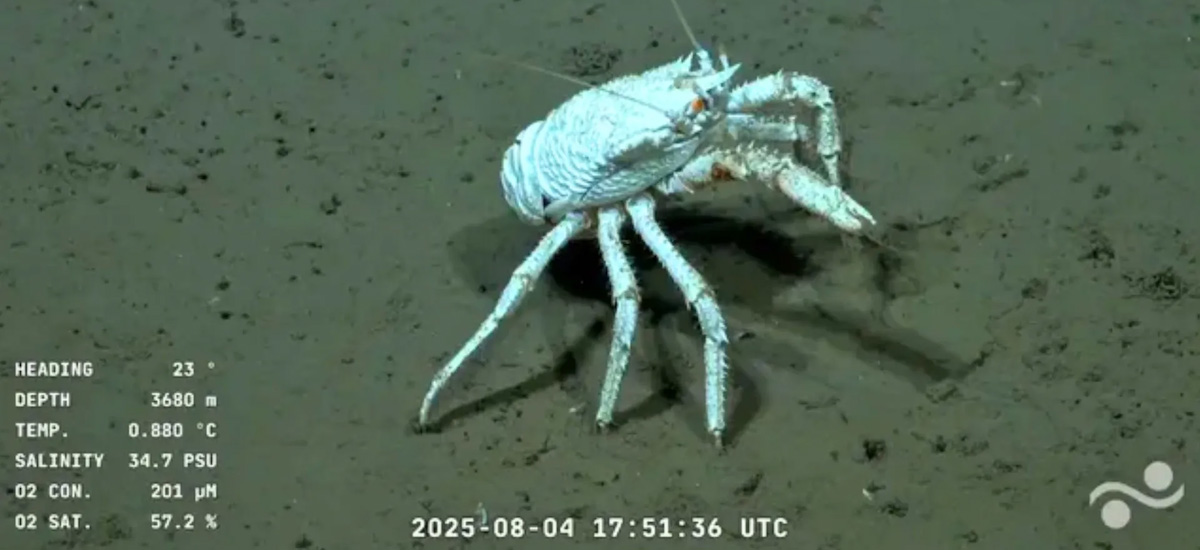The ocean is full of wonders, mysterious and mostly uncharted. We don’t know what we’ll find when we start diving deeper and deeper. It’s fascinating and also a little scary. On occasion, the Internet can be a little scary, too; many times, we don’t know what or who we are going to find in its depths. But sometimes, you find something really special.
For the last couple of weeks, a scientific expedition with 25 scientists from Argentina’s CONICET (the National Scientific and Technical Research Council) aboard the Schmidt Ocean Institute’s Falkor (too) vessel have started exploring the Mar Del Plata submarine canyon just a couple of kilometers off the coast from one of the country’s favorite vacation spots.
Using a remotely operated vehicle (ROV) called Subastian to dive at 4000m depths, the scientists are attempting to explore, document, record, and extract samples of soil, water, animal, and vegetal life.

Perhaps, dear reader, you are wondering: what does the Internet have to do with it? Well, here’s the thing: each dive is broadcast live through the Schmidt Ocean Institute’s YouTube channel, using high-definition cameras and a 4000m long underwater fiber that transmits the ROV images to the boat. Each dive is narrated by a group of scientists, who comment and explain the sightings and findings, the actions that are taking place, and what’s going to happen afterwards.
This still might seem interesting, but not necessarily impressive, so here’s where the wonder comes in: tens of thousands of people are joining those streams at all times of day: 10 a.m. dive, 30k people watching; 6 p.m., 80k; 3 a.m., 30k! (For those who don’t know, we Argentinians are passionate about everything, and wherever there’s one of us doing something publicly, we are there to support.)
Right now, while I’m writing this, there are 40,800 people watching a coral reef and listening to a biologist talk about the different colors. A few days ago, 147k people watched while the team discovered and collected an unknown type of crawfish.
And people aren’t just silently viewing. People are taking part, asking questions through the live chat, sharing their opinions, creating artwork, and participating in a scientific expedition in a way that has never been possible up to now.
Memes—of course—are being created and going viral, art is being created, and people are sharing their experience of watching this with each other. Public recognition went through the roof very quickly, a couple of days after this expedition started beating every other streaming content in the country, including interviews with the president.

So, let’s talk a little bit about the boat connections. According to the Schimdt Ocean Institute’s website, the 110m long vessel has it’s own fiber backbone network, copper branches, several physical and virtual networks (that might be configured as needed), Wi-Fi available at all boat areas, and satellite connections.
This collective experience, this conversation between everyday people and scientists exploring the world, creating knowledge, interacting, inviting curiosity, sparking interest in scientific careers for children, is only possible because of the Internet, because millions can easily connect to a platform where a group of scientists can easily share what they are doing live, at any time, any day, almost anywhere in the world. A scientific expedition turned into a mainstream event, a cultural milestone, a shared experience.
This is truly a wonder of the Internet, the Internet we need to protect and to grow because it is a place of opportunity, a place of human connection, a place of wonder.
Imagine all the interesting and amazing things that are happening around the world that we are missing out on, that the world does not know about, because a third of the world does not have the Internet connection to share it.
Help support our vision of an Internet for everyone. Donate to the Internet Society today.
Images © Schmidt Ocean Institute

